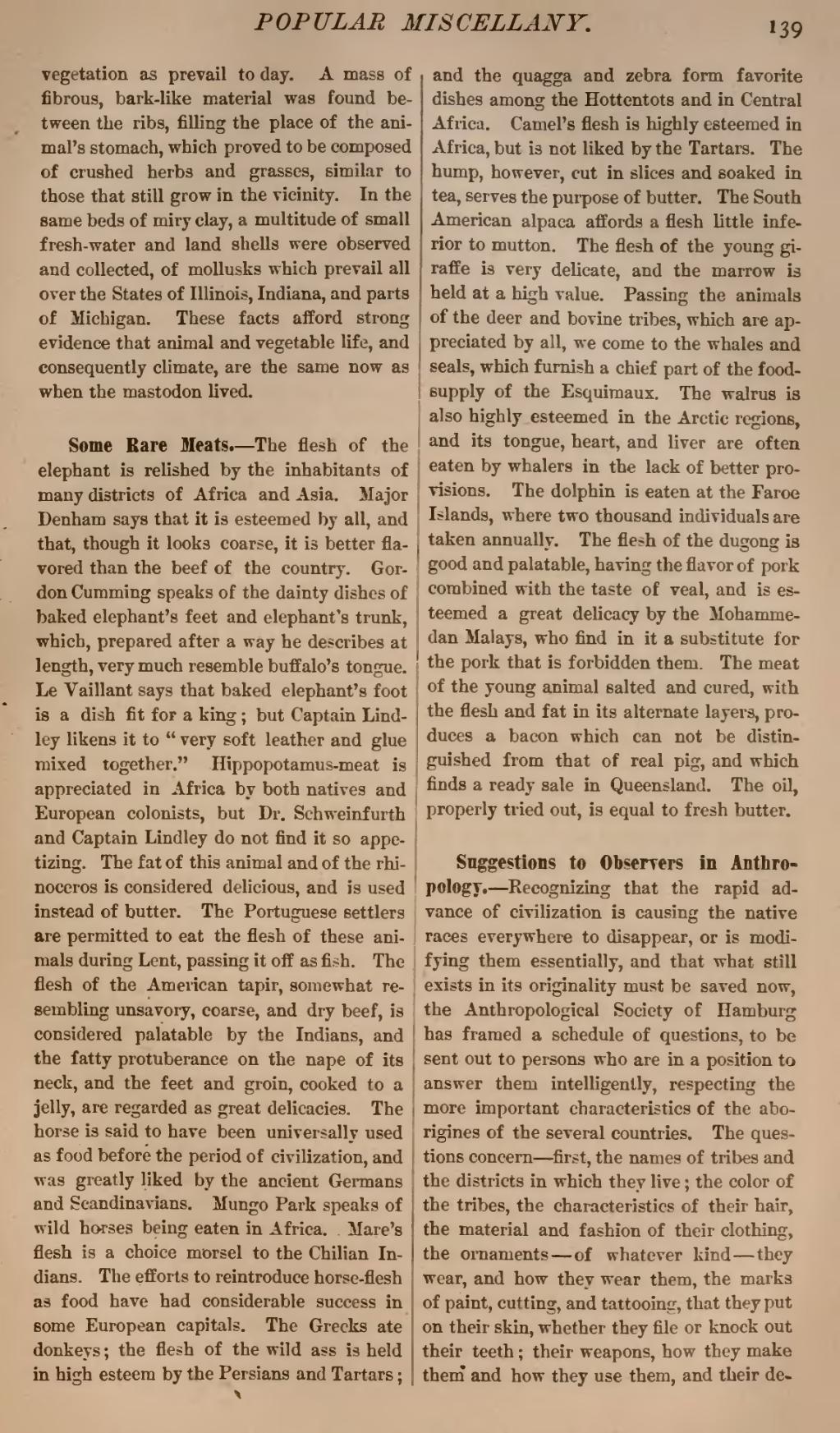vegetation as prevail to day. A mass of fibrous, bark-like material was found between the ribs, filling the place of the animal's stomach, which proved to be composed of crushed herbs and grasses, similar to those that still grow in the vicinity. In the same beds of miry clay, a multitude of small fresh-water and land shells were observed and collected, of mollusks which prevail all over the States of Illinois, Indiana, and parts of Michigan. These facts afford strong evidence that animal and vegetable life, and consequently climate, are the same now as when the mastodon lived.
Some Rare Meats.—The flesh of the elephant is relished by the inhabitants of many districts of Africa and Asia. Major Denham says that it is esteemed by all, and that, though it looks coarse, it is better flavored than the beef of the country. Gordon Cumming speaks of the dainty dishes of baked elephant's feet and elephant's trunk, which, prepared after a way he describes at length very much resemble buffalo's tongue. Le Vaillant says that baked elephant's foot is a dish fit for a king; but Captain Lindley likens it to "very soft leather and glue mixed together." Hippopotamus-meat is appreciated in Africa by both natives and European colonists, but Dr. Schweinfurth and Captain Lindley do not find it so appetizing. The fat of this animal and of the rhinoceros is considered delicious, and is used instead of butter. The Portuguese settlers are permitted to eat the flesh of these animals during Lent, passing it off as fish. The flesh of the American tapir, somewhat resembling unsavory, coarse, and dry beef, is considered palatable by the Indians and the fatty protuberance on the nape of it's neck and the feet and groin cooked to a jelly, are regarded as great delicacies. The horse is said to have been universally used as food before the period of civilization, and was greatly liked by the ancient Germans and Scandinavians. Mungo Park speaks of wild horses being eaten in Africa. Mare's flesh is a choice morsel to the Chilian Indians. The efforts to reintroduce horse-flesh as food had considerable success in some European capitals. The Greeks ate donkeys; the flesh of the wild ass is held in high esteem by the Persians and Tartars; and the quagga and zebra form favorite dishes among the Hottentots and in Central Africa. Camel's flesh is highly esteemed in Africa, but is not liked by the Tartars. The hump, however, cut in slices and soaked in tea, serves the purpose of butter. The South American alpaca affords a flesh little inferior to mutton. The flesh of the young giraffe is very delicate, and the marrow is held at a high value. Passing the animals of the deer and bovine tribes, which are appreciated by all, we come to the whales and seals. which furnish a chief part of the food-supply of the Esquimaux. The walrus is highly esteemed in the Arctic regions and its tongue, heart, and liver are often eaten by whalers in the lack of better provisions. The dolphin is eaten at the Faroe Islands, where two thousand individuals are taken annually. The flesh of the dugong is good and palatable, having the flavor of pork combined with the taste of veal, and is esteemed a great delicacy by the Mohammedan Malays, who find in it a substitute for the pork that is forbidden them. The meat of the young animal salted and cured, with the flesh and fat in its alternate layers, produces a bacon which can not be distinguished from that of real pig, and which finds a ready sale in Queensland. The oil, properly dried out, is equal to fresh butter.
Suggestions to Observers in Anthropology.—Recognizing that the rapid advance of civilization is causing the native races everywhere to disappear, or is modifying them essentially, and that what still exists in its originality must be saved now, the Anthropological Society of Hamburg has framed a schedule of questions, to be sent out to persons who are in a position to answer them intelligently, respecting the more important characteristics of the aborigines of the several countries. The questions concern—first, the names of tribes and the districts in which they live; the color of the tribes, the characteristics of their hair, the material and fashion of their clothing, the ornaments—of whatever kind—they wear, and how they wear them, the marks of paint, cutting, and tattooing, that they put on their skin whether they file or knock out their teeth; their weapons, how they make them and how they use them, and their de-
